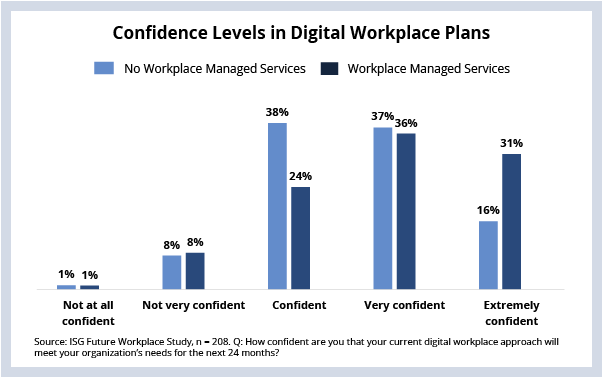If someone forwarded you this briefing, consider subscribing here.
WORKPLACE MANAGED SERVICES
In our recent ISG Buyer Behavior study on future workplace, we asked large enterprises how they are staffing a variety of workplace functions. Of the organizations we asked, 16% reported they are using managed services, 42% are using staff augmentation and 42% are primarily supporting their workplace with internal staff. Data center support is most likely to be performed by staff augmentation, while cybersecurity services are most likely to be done in-house.
The relatively small proportion of firms using managed services report a much greater confidence in their digital workplace plan and its ability to meet their needs over the next 24 months (see Data Watch).
One reason for this is that managed services are defined in terms of outcomes rather than inputs. Managed service providers are incented to measure performance toward specific objectives and to react with modifications to meet those targets. An enterprise might say managed services set them up to react more quickly to future changes.
And what do enterprises anticipate over the next 24 months? Mobile devices, knowledge management, unified communications and IT self-service portals all rank as “critical” or “very important.” Given that companies have a workforce that is still an average of 14% more remote than pre-pandemic, they know technology will play a critical role in keeping employees engaged and productive.
In our ISG Provider Lens research, we found that workplace managed service providers are all early adopters of digital employee experience (DEX) measurement technologies like Nexthink, Lakeside and Systrack. These tools and other measurement and management platforms are the foundation of the kinds of experience level agreements (XLAs) we see being adopted into managed services deals. This data further explains why enterprises that are using managed services to support their workplace environments have more confidence in their market-readiness than those that do not.
DATA WATCH

